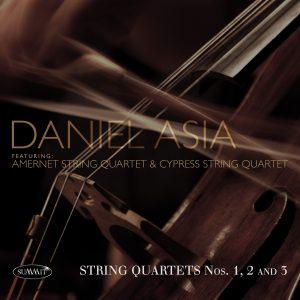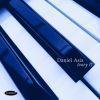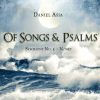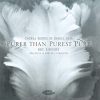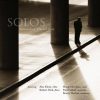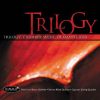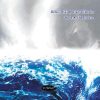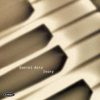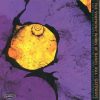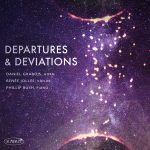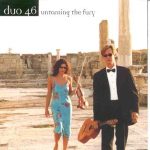String Quartets Nos. 1, 2 and 3 – Daniel Asia
Featuring: Amernet String Quartet & Cypress String Quartet
Together, these three quartets give a wonderful view of the progression and development of this seminal composer’s compositional style generally, and in the medium of the string quartet genre specifically.
String Quartet No. 1, written in 1975, is a highly eclectic work in its stylistic inflections. In five movements of highly varied emotional content, it mixes the lyrical with the fantastic, the hyper-present with the remote, the galactically spatial with the intensely rhythmic.
String Quartet No. 2, from 1985, is in four contrasting movements, with much of it about a theme and its variations. Like the earlier string quartet, it mixes the ghostly and nightmarish with the serene and peaceful, as it pushes to the fullest the emotional and physical range of the string quartet.
String Quartet No. 3 (The Seer), commissioned by the Cyrpress String Quartet in 2006 as part of their call and response series, takes its title from Adolph Gottlieb’s eponymous painting, that sees quite analogous to my quartet. The works are mosaic-like in their larger structures. Seemingly incongruous shapes build up a pleasing and articulate form. Certain iconic shapes or patterns run through the work, while others stand in isolation. This quartet accepts certain influences from popular music which are absorbed into its more complex texture and language. While these associations don’t leap out, they are present, even if only on a subterranean level.
Praised for their “intelligence” and “immensely satisfying” playing by the New York Times, the Amernet String Quartet has garnered recognition as one of today’s exceptional string quartets and are Ensemble-in-Residence at Florida International University in Miami.
In their 20 years on the concert stage, Cypress String Quartet (CSQ) have been praised by Gramophone for their “artistry of uncommon insight and cohesion,” and by the NY Times for “tender, deeply expressive” interpretations.
REVIEW:
Daniel Asia is a composer of fertile imagination, his music serious and, in its frequent complexity, inviting repeated listening. In his writing for string quartet, it feels like there is a concentration of expression when compared to his disc Breath in a Ram’s Horn(I interviewed Asia around that disc in Fanfare41:3).
Written while Asia was still at Yale, the First Quartet (1975) is far from a student work, and the composer himself does not consider it such. It was premiered by the Rymour Quartet, who subsequently recorded it for Albany. Here, it is the Amernet String Quartet that does the honors. The music itself is complex, unforgiving in its soundscape but simultaneously subtle and, at times, unbearably expressive. The advantage the Summit release has is Asia’s three quartets in one place, of course; the uniformly superb performance standards do not harm its claims, either. The piece is cast in five movements which are played without a break, although they are, helpfully, separately tracked. The long, slow expressive lines of the fourth movement (Lento) are particularly touching, revealing a Bergian intensity and bleeding into the enigmatic final “Misterioso”. Asia’s exploration of the sound capabilities of a quartet via extended techniques is remarkable in that one hardly notices it per se, it is actually so integrated into his musical argument and, indeed, his musical voice.
The String Quartet No. 2 (1985) is a set of variations on a tripartite theme; those variations are grouped into four movements. Asia states that it is “built from” his piece Marimba Music. Whereas Asia’s first foray into the quartet medium was pithy (the finale, at four minutes, is the longest), the Second Quartet is far more extended, the first movement alone nearly ten minutes in duration; and, as we have seen, the movements are themselves formal segmentations of the overall variations structure. Although compositional rigor is still very much part of the formula, the overall effect is more lyrical than with the First Quartet. The superb performers here are the members of the Cypress Quartet (who in fact have been closely linked to all three quartets, and, indeed, show incredibly affinity for the music here).
It was in fact the Cypress Quartet’s “Call & Response” program of commissioned works was influential in the gestation of the Third Quartet, although it is the Amernet Quartet that performs it here. Composed in the context of a series that considered the ramifications inherent within older works, it was Dvořák’s op. 96 Quartet, “American,” that formed the basis of Asia’s inspiration, of that older composer’s links between old and new musics. Post-compositionally, Asia has linked the Third Quartet also to the abstract painting The Seerby Adolph Gottlieb, which the composer came across in Washington D. C.’s Phillips Gallery, particularly in the use of mosaic. Asia casts his work in seven movements, linking movements in a variety of ways while also including an influence from popular culture (“it is one way of raising the vernacular to the refined, the mundane to the sacred,” he says). The performance is remarkable, not least in the incredibly touching “Adagio, soulful” fifth movement, while the penultimate “Playful, cantabile” offers the equivalent of delicious shade on a hot Summer’s afternoon.
These string quartets demand to be heard, especially in performances as committed as these. Asia’s mind seems to be continuously exploring, and that freshness seeps into his scores. It is hard to imagine finer performances in finer recordings.
-Colin Clarke for FANFARE



